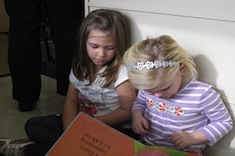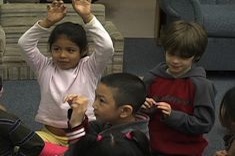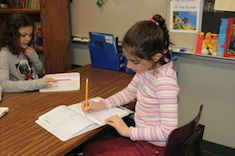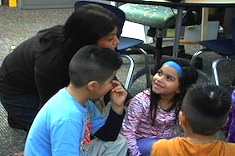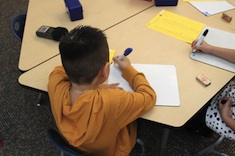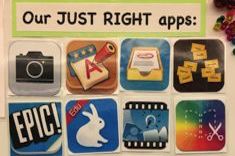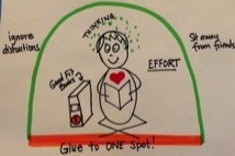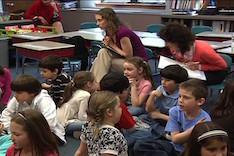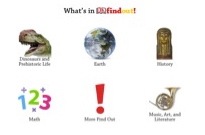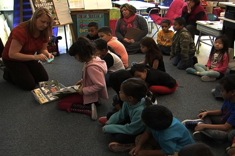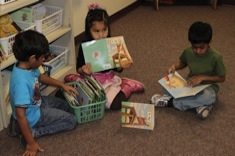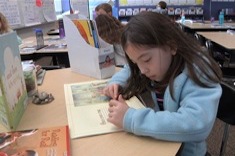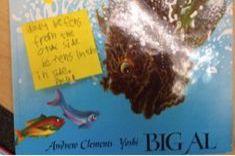1st
Latest Content
Creating a Space for Peace
At a time of escalating violence throughout the world, children need peaceful spaces. Katie DiCesare creates a "peace table" in her first-grade classroom as a safe place for working through everything from playground squabbles to emotional distress.
Helping Young Readers Focus on Print
Shari Frost observes a teacher conferring with a first grader who is mystified at the advice to "get your mouth ready," and it leads her to consider what works best in helping young readers.
Thinking About Fluency
Cathy Mere finds that with young learners, not all issues with fluency are created equal—different needs require different strategies.
Fostering Thinking Through Play
Katie DiCesare repurposes materials for her first graders to play with, and finds that encouraging play early in the year is a great tool for building reflection skills.
Making Plans for Summer Reading
Tara Barnett and Kate Mills begin a few days before the start of break to help students develop summer reading goals and plans.
Purposeful Partners
Tara Barnett and Kate Mills find the young learners in their classroom have mastered the art of turning and talking only with close friends. They provide practical suggestions for expanding the circle of peer response.
Culturally Responsive Texts
Katrina Edwards is horrified when a student response reveals cultural gaps in her first-grade classroom library. She researches possibilities for expanding the diversity of texts, and shares an annotated bibliography to download linking different cultures and curricular possibilities.
Choosing and Refining Student Goals
Katie DiCesare shares the process of having her first graders choose their literacy goals, and her role in helping them refine goals through observation and conferring.
Temporary Strategies
Clare Landrigan confers with a student and discovers that a tool designed to help the reader is actually hindering her learning. The experience causes her to reflect on the need for flexibility when matching strategy scaffolds to young readers.
Supporting Talk Around Writer’s Craft
Tara Barnett and Kate Mills help young writers move away from seeing editing as “adding more details,” and toward developing more specific language for the revision process.
Modeling Nonfiction Writing for English Language Learners: Part 3
Stella Villaba models nonfiction writing for her first- and second-grade English language learners, and in the process integrates vocabulary instruction into her lesson. This is the final video in a three-part series.
Modeling Nonfiction Writing for English Language Learners
Stella Villalba models nonfiction writing for her first- and second-grade English language learners, and in the process integrates vocabulary instruction into her lesson. This is the first video in a three-part series.
Learning Vocabulary in Context with English Language Learners
Stella Villalba explores why it is so important to teach vocabulary to English language learners in context.
The Compliment Conference
Katrina Edwards confers with Camilla, a struggling reader. She is a child who has no confidence in herself. The Compliment Conference is a way to acknowledge and build upon Camilla’s strengths, and boost her self-esteem at the same time.
Growing Toward Independence
Cathy Mere shares what to look for and what to try next with young learners who are easily distracted and struggling to concentrate during independent reading.
Knowing Ami: Silent Communication with an English Language Learner
Katie DiCesare finds patience and observation are the keys to helping a first-grade English language learner who is in the silent period.
Jumping into Just-Right Apps
We spend a lot of time in elementary classrooms matching students to “just-right” books. Katrina Edwards uses similar principles to help her first-grade students pick just-right apps. The essay includes a downloadable chart of appropriate literacy apps for young learners.
Bringing Writers’ Voices Home with QR Codes
Bitsy Parks has her first-grade students record their writing as part of a regular workshop and assessment routine, and then uses QR codes to share the recordings with families and the larger community.
Stamina Bubbles
“Why do you always say ‘Happy reading!’ to us?” This question from a first grader leads Katrina Edwards to develop visual support tools for building stamina during reading workshops.
Moving Beyond Bed-to-Bed Stories in First Grade
Katrina Edwards moves her first graders from writing "bed-to-bed" stories early in the year with a mentor text and writing activity that promotes self-discipline and a growth mindset.
Stories from Illustrations: Conferring with Kendall
Ruth Ayres draws out the story-writing possibilities with first-grader Kendall by conferring over her illustrations.
Little Levels, Big Thinking
Katie DiCesare moves beyond levels to consider her first-grade readers’ needs.
Reading, Engagement, and Kidwatching
Katrina Edwards looked around her first-grade reading workshop one day in winter and it wasn’t a pretty picture. Many students were doing anything but reading. She develops a plan to approach the issue of time on task thoughtfully.
Reorganizing Primary Information Texts
Katie DiCesare thinks about the needs of her first-grade students, and spends some time reorganizing primary information texts, considering both physical texts for the library and online resources.
Understanding Fiction and Nonfiction in First Grade
This is a demonstration lesson in a first-grade classroom on understanding the difference between fiction and nonfiction led by Erin Quealy. It is the first video in a three-part series.
Embracing Meaning Making in Guided Reading Groups
Katie DiCesare finds her guided reading practices are rusty, so she develops some new strategies to improve her work.
Reading Workshop Routines in First Grade
Bitsy Parks explains the routines and procedures in her first-grade reading workshop.
Potato the Crow: Blurring the Lines Between Reality, Fantasy, and Play with Young Learners
Leslie Woodhouse discovers a dollar store find takes on a life of its own in her preschool classroom in this delightful essay.
Anchoring Language
Katie DiCesare thinks about what language supports student independence early in the year and how to share this in an anchor chart with her first graders.
Getting to Know a Young Reader
As she confers with first grader Kendall, Deb Gaby skillfully weaves questions about home and reading together.
Browse Content By
Type
Category
- Assessment Tools
- Big Fresh Archives
- Booklists
- Choice Numeracy
- Classroom Design
- Common Core
- Community Building
- Conferring
- Content Literacy
- Digital Literacy
- English Language Learners
- Equity
- Family Relations
- Free Samples
- Guiding Groups
- Leadership
- Literacy Coaches
- Mentor Texts
- Minilessons
- New Teacher Mentors
- Podcasts
- Poetry
- Quote Collections
- Reading Strategies
- Self Care
- Struggling and Striving Learners
- Talking and Listening
- Teacher Study Groups
- Teaching Reading
- Teaching Writing
- Word Study and Vocabulary
Author
- Melissa Quimby
- Nawal Qarooni
- Gwen Blumberg
- Julie Cox
- The Lead Learners
- Hannah Tills
- Josie Stewart
- Ruth Metcalfe
- Mallory Messenger
- Becca Burk
- Jodie Bailey
- Vivian Chen
- Mary Brower
- Tiffany Abbott Fuller
- Stephanie Affinito
- Ruth Ayres
- Leigh Anne Eck
- Heather Fisher
- Shari Frost
- Julie Johnson
- Suzy Kaback
- Gigi McAllister
- Shirl McPhillips
- Melanie Meehan
- Cathy Mere
- Debbie Miller
- Tara Barnett and Kate Mills
- Tammy Mulligan
- Dana Murphy
- Bitsy Parks
- David Pittman
- Brenda Power
- Heather Rader
- Matt Renwick
- Mandy Robek
- Christy Rush-Levine
- Gretchen Schroeder
- Jen Schwanke
- Brian Sepe
- Katherine Sokolowski
- Stella Villalba
- Jennifer Vincent
Grade Level
Choice Literacy Membership
Articles
Get full access to all Choice Literacy article content
Videos
Get full access to all Choice Literacy video content
Courses
Access Choice Literacy course curriculum and training


